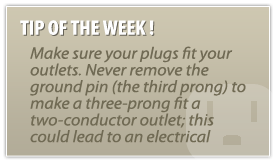Santana Electric Tips
Plugs
Make sure your plugs fit your outlets. Never remove the ground pin (the third prong) to make a three-prong fit a two-conductor outlet; this could lead to an electrical shock. NEVER FORCE A PLUG INTO AN OUTLET IF IT DOESN'T FIT. Plugs should fit securely into outlets. Avoid overloading outlets with too many appliances.
Circuit Breakers/Fuses
Circuit Breakers and fuses should be the correct size current rating for their circuit. If you do not know the correct size, have an electrician identify and label the size to be used. Always replace a fuse with the same size fuse.
Outlets
Check for outlets that have loose-fitting plugs, which can overheat and lead to fire. Replace any missing or broken wall plates. Make sure there are safety covers on all unused outlets that are accessible to children.
Cords
Make sure cords are in good conditions - not frayed or cracked. Make sure they are placed out of traffic areas. Cords should never be nailed or stapled to the wall, baseboard, or to another object. Do not place cords under carpets or rugs or rest any furniture on them.
Extension Cords
Check to see that cords are not overloaded. Additionally, extension cords should only be used on a temporary basis; they are not intended as permanent household wiring. Make sure extension cords have safety closures to help prevent young children from shock hazards and mouth burn injuries.
Ground Fault Circuit Interrupters (GFCIs)
GFCIs can help prevent electrocution. They should be used in any area where water and electricity may come into contact. When a GFCI senses current leakage in an electrical circuit, it assumes a ground fault has occurred. It then interrupts power fast enough to help prevent serious injury from electrical shock. Test GFCIs regularly according to the manufacturer's instructions to make sure they are working properly.


